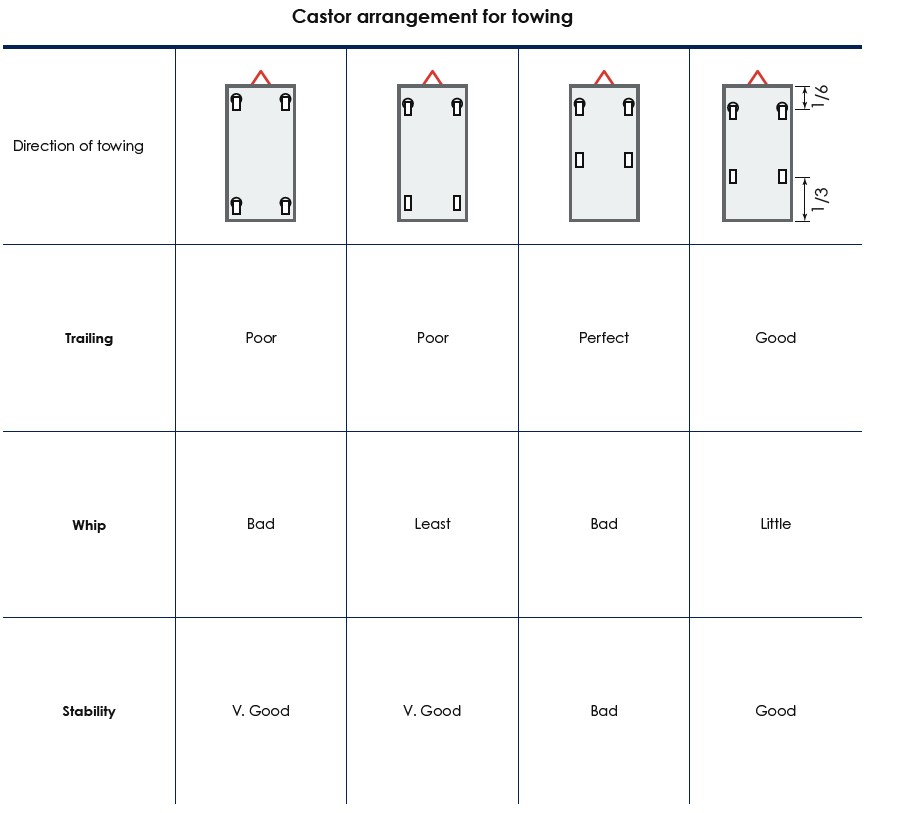About towing
When the load is too heavy to push, you will need to use other ways.
Why not tow the load?
There are restrictions to what a human being can be asked to push and even a forklift or pallet truck has limitations. Basically, it can only move one pallet or load at a time. If there is a lot of material to be moved over some distance, there’s a good economic argument for using more trolleys. In fact, a forklift can usually tow a trolley, but for multiple trolleys in a train, a specialized tug is needed. You’ll see them in use at airports, docks, railway stations and heavy engineering works and car assembly plants, and they’re generally used whenever loads are to be moved continuously over longer distances. To add to their usefulness, trailers are often specially modified to contain loads more safely, or to act as a jig or part of the work holding fixture. The load can then be wheeled to a work-centre, worked on, and then wheeled away, without ever leaving the trailer, thus reducing handling time and effort. Trailers can also be matched to the height of a work surface, so the load can be slid directly on and off the work area.
Where should you tow?
In short, anywhere where a trolley can be manoeuvred safely. Modern wheels and castors are designed for many different surfaces, smooth or rough, indoors or out. Different systems of towing suit different environments, but in general, there is a system, and a wheel or castor, for every application.
Tugs used indoors, in warehouses, factories, etc., are restricted by safety regulations to about 10km/hr. But even at this low speed, both the wheel and castor can suffer severe impact from uneven surfaces and obstacles, so the castors chosen must be strong enough to cope. Outdoor use can be even more severe, so we recommend larger diameters with a thick cushion of polyurethane or rubber in these conditions.
How to tow
Tractive power can come from either under-floor or overhead mounted track towing systems, or free movement motorized tugs.
Tugs (free movement)
There are various types of electric powered tugs available and all allow greater flexibility. However, they do require an operator/driver, so to be efficient they need to use multiple trolleys to form a train. Usually one tug can handle three groups of trailers - one being pulled, one loading, and one unloading. Tugs used to tow one or more trolleys have many advantages in flexibility, but this often results in wheels and castors being pulled at high speeds over uneven surfaces, hitting grates, rails, weather lips at doors and so on. Therefore, castors for power towing must be especially strong. The rougher the use, the larger the wheel diameter and the stronger the castor you must use.
Towing considerations
Trolleys to be power-towed need special arrangements: (see illustration)
Four swivel castors will not trail properly behind the towing unit - they will cut corners rather than follow the unit. They will also tend to ‘whip’ - to over correct any sideways displacement and sway from side-to-side as they travel. These problems become more acute if two or more trolleys are linked in a train.
If two fixed castors are used at the rear of the trolley it eliminates the whip, but the trolley does not trail properly. A good compromise is to mount 2 swivel castors 1/6 of the length of the trolley from the front of the trolley and two fixed castors 1/3 of the length of the trolley from the rear. This gives little whip, and good trailing. Note though, that such trolleys should not have a heavy load concentrated at the rear end or they will tip backwards.
When positioning the tow hitches, experiment to ensure the trolleys do not hit each other (or the tug) going around tight corners. The wider the trolley, the further out the tow hitches will need to be.
Paint the tow hitches a bright yellow for safety. If you make them to swing up out of the way, then fit them with safety catches so they do not drop down causing injury or damage.
ALWAYS make the mounting pads rigid enough not to bend under severe use. Castors must be mounted with the mounting plate truly horizontal if the castor is to swivel freely and track correctly. If the mounting bends the castor will crab to the side or develop a “fish tail” action.

